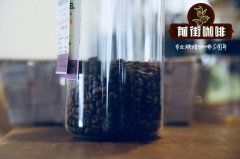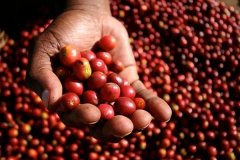Illustration | you need a guide to making layered latte coffee suitable for making latte beans
Professional coffee knowledge exchange more coffee bean information please follow the coffee workshop (Wechat official account cafe_style)
There is a common sense in making lattes that if you want to make a beautiful latte, you should pour milk into espresso, not the other way around. But what happens the other way around? This will make another latte: layered latte (layered latte). To make a layered latte, you pour espresso into a cup of milk.

| what is the secret of making a layered latte?
If espresso is poured into the milk too slowly, the denser fluid will mix too evenly with the lower density to make a layered latte. The faster dumping speed causes the denser fluid to impact the lower density fluid and causes rapid motion to achieve the expected stratification when the density equilibrium is established.
Even with a mild stir, such as a sip, layering can form and remain for minutes, hours, or even days. As long as the temperature of the latte is higher than the surrounding air, stirring produces another density gradient, similar to that produced by pouring espresso. But when the latte is stirred at room temperature, the layering will be goodbye forever. They published their findings in the journal Nature Communications.

| Why is it important to understand the stratification principle of liquids?
Stone and doctoral student Xue Nan and others used a set of LED lights and cameras to capture the delamination process and observed that when coffee is poured into heated milk, there is a phenomenon called double diffusion convection (double-diffusive convection), which produces different density layers in the liquid.
After remaking lattes from their own espresso and milk, they developed a simulated drink in which heated and dyed fresh water was injected into denser heated salt water containing particles that could scatter a green laser beam. mixed to test the scientific parameters that make this spontaneous stratification possible. They then conduct simulations to collect data to compare various models of different systems.

They found that pouring hot coffee into hot milk at a certain rate caused an interaction between temperature and density, causing the beverage to be divided into layers of different densities. The same basic phenomenon known as double diffusion convection forms a water layer in the ocean. Different concentrations of salt water have different densities, just like espresso in lattes and higher-density milk.
When the liquid tries to mix, the temperature gradient causes part of the liquid to heat up, become lighter and rise, while the other part with higher density sinks. This sinking and rising movement stops when the local density of an area in a cup of latte is close to equilibrium. As a result, the fluid must flow horizontally, not vertically, thus forming different layers.

The following is the formula we use when using VST20 gram filter bowl
▼
-Water temperature | 93-94 ℃
-pressure | 9 ba
-freshly ground coffee powder | 19-20g (using electronic scales)
-Total weight of coffee | 36-40 grams (using electronic scales)
-brewing time | 25-28 seconds (using timer)

If you are using a 22 g filter bowl, please use 22 g freshly ground coffee powder. The total weight of coffee should be 44 g, the ratio should be 1:2.
Maple ice latte
Maply Syrup Latte
1. Fill the glass with 5% ice cubes and add 10 grams of maple syrup.


2. Pour the fresh milk into the cup until it is seven minutes full, then stir well so that the syrup is melted into the fresh milk to increase the proportion of fresh milk.

3. Let the coffee slowly pour into the cup along the spoon, not too fast, so as not to destroy the sense of hierarchy.

4. Finish
Important Notice :
前街咖啡 FrontStreet Coffee has moved to new addredd:
FrontStreet Coffee Address: 315,Donghua East Road,GuangZhou
Tel:020 38364473
- Prev

How to describe the flavor of Rwandan coffee _ how to drink Rwandan coffee _ where to buy Rwandan coffee beans
Professional coffee knowledge exchange more coffee bean information Please follow the coffee workshop (official Wechat account cafe_style) the Rwandan coffee beans in my memory have obvious wild ginseng flavor and high sweet taste, this time the hot drink extracted by the wind did not taste wild ginseng, but there was a transient taste of wild ginseng on the upper jaw when the coffee liquid cooled. And the imported fruit acid also tends to plum fruit. Data simplification
- Next

Ethiopian Gemma | from Ethiopia, the birthplace of coffee, the ancient sun beans
[Gemma, Ethiopia] country: Ethiopia: Gemma altitude: 1800m treatment: sun varieties: local native species 01 | production areas introduce Ethiopia as the birthplace of coffee. Legend has it that an unknown shepherd found this mysterious red fruit that has been selling so far while herding his sheep in the forests of western Ethiopia: coffee, opened.
Related
- Detailed explanation of Jadeite planting Land in Panamanian Jadeite Manor introduction to the grading system of Jadeite competitive bidding, Red bid, Green bid and Rose Summer
- Story of Coffee planting in Brenka region of Costa Rica Stonehenge Manor anaerobic heavy honey treatment of flavor mouth
- What's on the barrel of Blue Mountain Coffee beans?
- Can American coffee also pull flowers? How to use hot American style to pull out a good-looking pattern?
- Can you make a cold extract with coffee beans? What is the right proportion for cold-extracted coffee formula?
- Indonesian PWN Gold Mandrine Coffee Origin Features Flavor How to Chong? Mandolin coffee is American.
- A brief introduction to the flavor characteristics of Brazilian yellow bourbon coffee beans
- What is the effect of different water quality on the flavor of cold-extracted coffee? What kind of water is best for brewing coffee?
- Why do you think of Rose Summer whenever you mention Panamanian coffee?
- Introduction to the characteristics of authentic blue mountain coffee bean producing areas? What is the CIB Coffee Authority in Jamaica?

